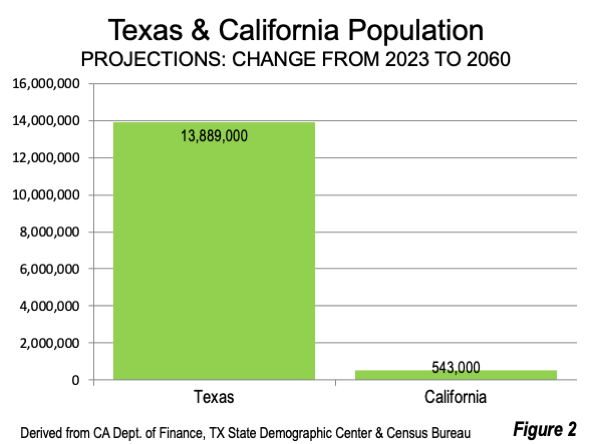
Recently we reported that current, official population projections by state agencies indicate that Texas will become the most populous state by 2050. Over the following 10 years, the gap is projected to increase to nearly 5,000,000, with Texas at 44.4 million and California at 39.5 million (Figure 1).

If these projections turn out to be correct (and projections are often not accurate, as conditions change), Texas will add 13.9 million residents, more residents than live in Pennsylvania, while California would add 500,000, about the population of the city of Fresno (Figure 2).

There would be substantial changes in the comparative populations at the local level. This is evident in an analysis of the three largest metropolitan areas in the two states, Los Angeles, Dallas-Fort Worth and Houston.
Currently Los Angeles, Dallas-Fort Worth, and Houston are the second, fourth, and fifth largest metropolitan areas in the United States. Currently, metro Los Angeles is by far the most populous of the three, with a population of 12.8 million (2023). This is 4.7 million larger than Dallas-Fort Worth (8.1 million) and 5.1 million larger than Houston (7.7 million).
Metropolitan areas, (also called functional cities or city-regions by demographers) are composed of complete counties. Metro areas are defined by the Office of Management and Budget based on commuting data. This article estimates metropolitan area populations in 2060 based on the present county components and the official county projections.
This analysis uses the counties currently comprising the three metropolitan areas and their respective projections to estimate the overall population.
The data suggests that Dallas-Fort Worth would pass Los Angeles, to become the largest of the three metropolitan areas. With a projected population of 12.4 million, it seems likely that Dallas-Fort Worth would become the second most populous metropolitan area in the nation, following New York (Note). This would be an increase of more than 50% from its 2023 population.
Houston would nearly match the population of metro Los Angeles, at 11.4 million in 2060, just 200,000 less than Los Angeles. With Houston still growing and Los Angeles losing, it would not be long before Houston would pass Los Angeles (Figure 3 and Figure 4).


Among smaller Texas metros, there is constant speculation that Austin and San Antonio will be merged into a single metropolitan area. It seems more likely that the two will be converted into a combined statistical area (CSA), rather than an MSA, because CSAs have less stringent commuting requirements. Metro Austin’s 2060 population is projected to be 5.2 million, up from 2.5 million in 2023. San Antonio would reach 4.4 million in 2060, up from 2.8 million in 2023.
Among the smaller California metros, Riverside-San Bernardino would move from 4.7 million to 4.9 million. Metro San Francisco is projected to increase from 4.6 million to 5.2 million, San Diego would remain at 3.3 million and Sacramento would increase from 2.4 million to 2.8 million.
The limitations of this data should be recognized. The areas covered by population projections can change metropolitan area definitions as commuting patterns change. So that if counties are not currently meeting the metropolitan area, criteria should qualify later, it would be added to a metropolitan areas.
Metropolitan areas change over time. In the case of Los Angeles, for most of the 20th century, metro Los Angeles added more new residents than any other metropolitan area in the nation but now is expected to decline in the next few decades. The situation is not much better statewide. As late as 2007, the California Department of Finance was projecting growth to 60 million by 2050. Over the period, California’s cost of living, driven by its overly regulated (and distorted) residential land market drove people to move elsewhere, with net 3.8 million (ins versus outs) moving elsewhere the nation.
The stagnation and even losses of California have to be among the most important demographic shifts in the history of the United States. From its 1850 admission to the Union, California has tended to grow well above the national average, at least before 2000. As for Texas, its advance has been, at least to some degree, propelled by the rising migration of both people and companies from California. The American future seems to be more Lone Star State than a Golden one.
Note: Population projections were not researched for the New York metropolitan area, however I expect that New York would remain the largest in the nation through at least 2060.
Wendell Cox is principal of Demographia, an international public policy firm located in the St. Louis metropolitan area. He is a Senior Fellow with the Frontier Centre for Public Policy in Winnipeg and a member of the Advisory Board of the Center for Demographics and Policy at Chapman University in Orange, California. He has served as a visiting professor at the Conservatoire National des Arts et Metiers in Paris. His principal interests are economics, poverty alleviation, demographics, urban policy and transport. He is co-author of the annual Demographia International Housing Affordability Survey and author of Demographia World Urban Areas.
Mayor Tom Bradley appointed him to three terms on the Los Angeles County Transportation Commission (1977-1985) and Speaker of the House Newt Gingrich appointed him to the Amtrak Reform Council, to complete the unexpired term of New Jersey Governor Christine Todd Whitman (1999-2002). He is author of War on the Dream: How Anti-Sprawl Policy Threatens the Quality of Life and Toward More Prosperous Cities: A Framing Essay on Urban Areas, Transport, Planning and the Dimensions of Sustainability.
Photo: Southern Methodist University, University Park, Dallas-Fort Worth via
Wikimedia in Public Domain.












